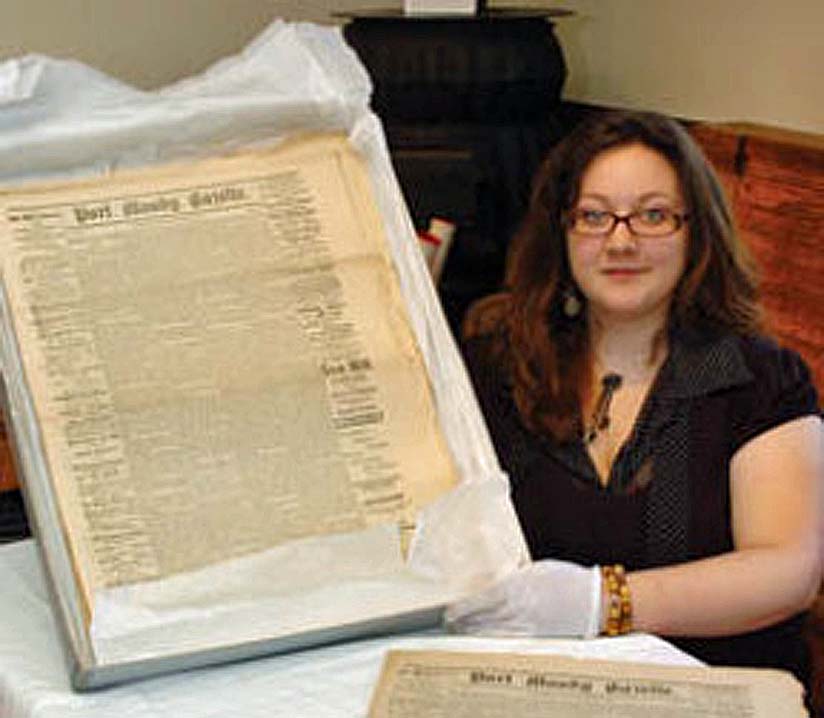












Port Moody British Columbia - A stack of yellowed newspapers so fragile they can't be touched without special gloves is Port Moody's only
link to its boomtown past.
But Port Moody Station Museum's curator Jim Millar hopes a project to scan 55 delicate issues of the Port Moody Gazette and convert the scans into Word
documents will extend the life of these precious documents and make them easier for researchers to use.
The Gazette published weekly from 1883 to 1887 for a growing population of townsfolk, Canadian Pacific Railway workers, and speculators who arrived after PoMo
was declared the terminus of the CPR. It ceased publication when Vancouver became the terminus and PoMo just a whistle stop on the transcontinental railway
line.
But for one exciting year, between 4 July 1886 and 23 May 1887, Port Moody was the end of the line and The Gazette, with exuberantly-written articles and
fawning editorials, was there to record the events of the day.
"It is quite a fascinating piece of history," Millar said of the period during which the newspaper operated on a scow in the inlet at the foot of
Queen Street as a branch office of the Mainland Guardian newspaper.
The four-page broadsheet newspaper was edited first by P.S. Hamilton, who quit to become a lawyer, and then by J.K. Suter, according to D.M. Norton's Early
history of Port Moody. It cost $2 a week and was sold by subscription.
For about four years, until CPR manager Cornelius Van Horne moved the railway terminus to Vancouver, Port Moody was touted to be one of the most important
cities on the Pacific Coast, possibly equal to San Francisco.
In tiny print, The Gazette promised readers that PoMo was destined to be a city of large mansions and elegant stores, and would need to soon start looking for
a site for a proper theatre.
"Not long hence (Port Moody will be) the most beautiful, the richest, the grandest, and in every way the best city on the Pacific Coast of America,"
the editor enthused in an editorial welcoming the New Year on 5 January 1884.
The paper also offered community news, including the comings and goings of various residents, the latest gossip about the monarchy, and even foreign news, on
topics as diverse as the settling of the Afghan boundaries and the successful opening of the opera Lohengrin in Germany.
Land speculators who flocked to the region in anticipation of the rail line bought advertisements for "Excellent farms for sale cheap," as did
surveyors and lawyers. Hotels sprang up, advertising rooms, and stabling. Merchants set up shop and promoted their wares, such as dress goods, imported ales,
wines and spirits, and Ayer's Sarsaparilla.
Business was good and the newspaper prospered.
But there were inklings that Port Moody's bright future was about to be dimmed.
Before the rail line to PoMo was even finished, Van Horne began to lobby officials for land to support the financially-strapped CPR and was eyeing Coal Harbour
and English Bay as potential sites for a new terminus.
When the news got out, residents who had bought land in anticipation of Port Moody's expansion sued CP but the legal wranglings ended in a victory for the rail
company.
The line was eventually pushed through and Port Moody was reduced to a near ghost town.
With barely disguised disgust, The Gazette stopped publishing nine days before the first train to Vancouver. The news pages, once alive with advertisements and
boosterish commentary, contained little to read but a serial feature "The Story of a Letter" written by Jullia Kavanagh, the conclusion of which was
never printed, and a lengthy report from the Court of Assizes.
As the city's greatest promoter, The Gazette was less than pleased that PoMo had been superseded by Coal Harbour. In a petulant editorial in the paper's last
issue, the editor wrote: "Port Moody and its surrounding now look very pretty, and will as time goes on, clearly convince even the most sceptical that it
is the site of the future great city of the province."

Port Moody Station Museum is located at 2734 Murray Street next to Rocky Point Park. It is open from 12:00 to 16:00 daily. Call
604-939-1648 for more information.
Author unknown.